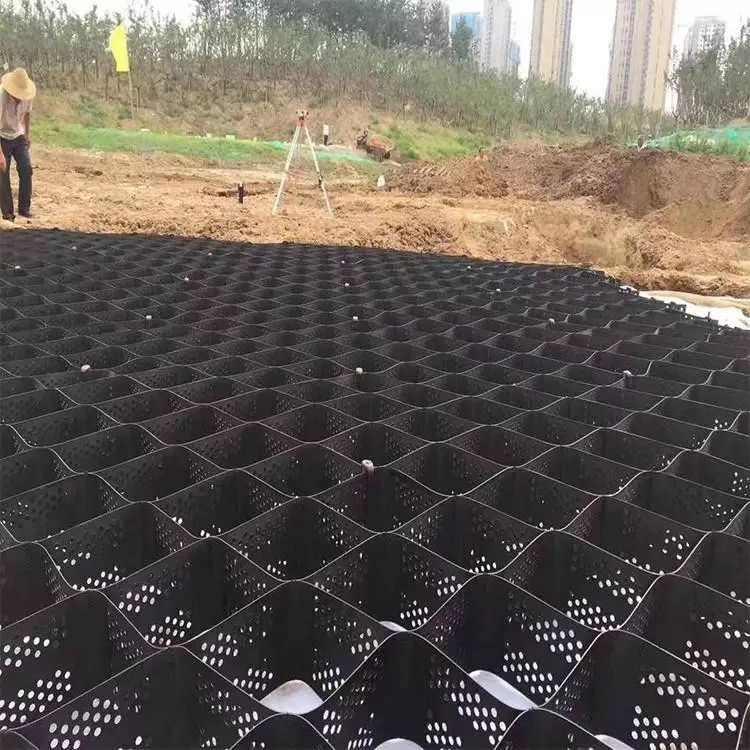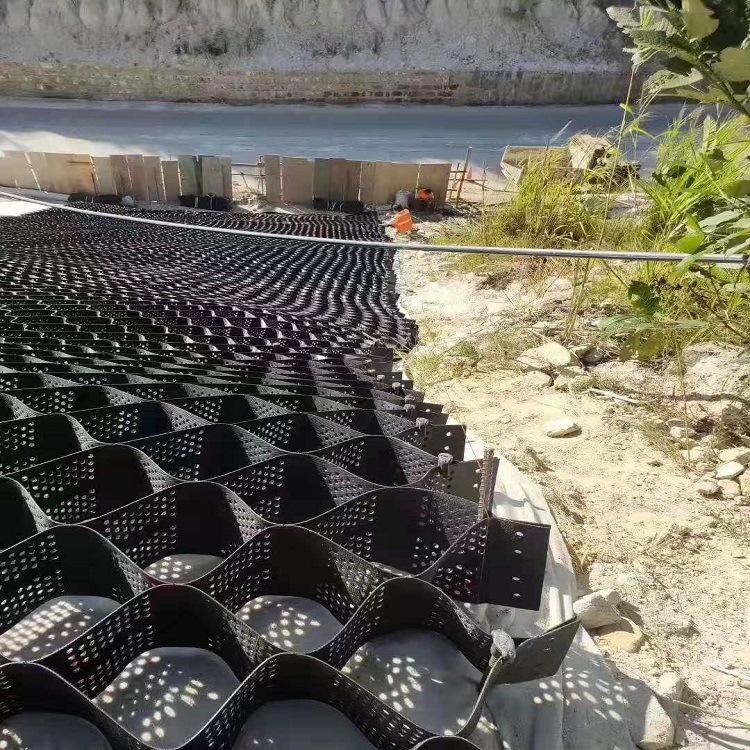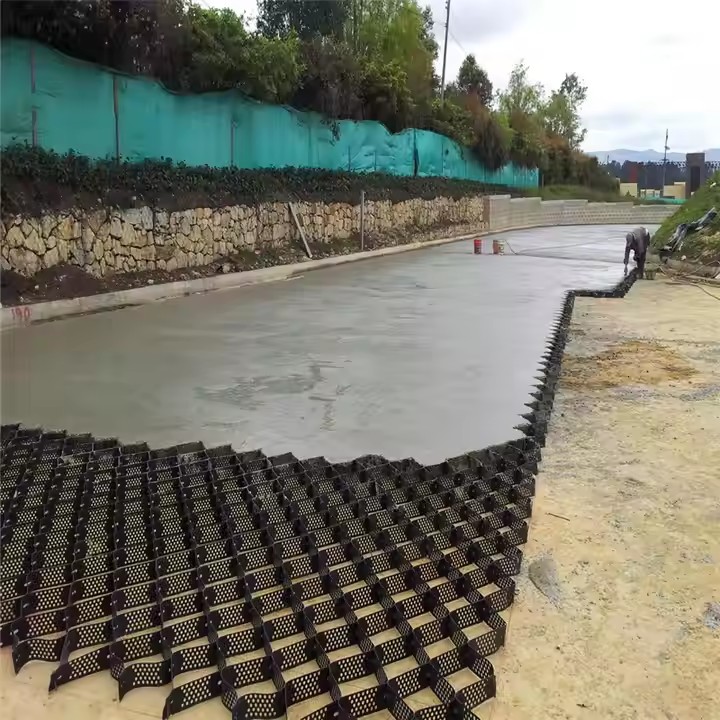Geocells make geotechnical protection more precise and efficient
Geocells: Making Geotechnical Protection More Precise and Efficient
In infrastructure work, geotechnical protection is key—plain and simple. It’s what keeps projects safe, durable, and built to last—no fancy jargon, just straight talk—from highway embankments and railway subgrades to slope stabilization and mine reclamation. Engineers and contractors have always focused on stopping soil and rock from eroding, shifting, or settling—let’s be honest, that’s the backbone of any solid project. Traditional methods like concrete retaining walls or gravel blankets have worked for decades, but they’ve got major downsides: high costs, slow installation, poor environmental impact, and trouble with tricky terrain. In recent years, geocells have changed the game. This innovative geosynthetic material brings precision, efficiency, and sustainability to the table. It’s more reliable, cost-effective, and eco-friendly than many old methods, so these days, it’s a top pick for modern infrastructure projects worldwide.
Geotechnical Headaches and Geocells’ Rise
Geotechnical issues shift with the project, ground conditions, and location—no two jobs are ever really the same. But some problems just keep popping up. Soil erosion’s a big one—slopes and embankments in rainy or windy areas lose soil fast, leading to slope failures, sunken roads, and damage to nearby structures. Concrete slopes can stop erosion, but they’re rigid—crack when the ground shifts or temperatures change, so you’re always fixing them. Weak soil is another headache; it can’t handle heavy loads, so roads and foundations settle unevenly over time. Most traditional methods also use tons of concrete or steel, which is bad for carbon emissions and throws local ecosystems out of whack.
Geocells fix these issues with a simple but clever design—3D honeycomb shapes made from tough polymers like HDPE or PP. Unroll ’em, stretch ’em out, fill ’em with soil, sand, gravel, even plants—and they lock into a solid system. This setup holds fill in place, stops sideways sliding, and spreads loads better. Unlike concrete, geocells are flexible—handle small ground shifts without cracking, so they stay stable for years. What makes them stand out is targeted protection. They work for everything from light-use paths to heavy-duty airport runways. Picking the right geocell specs matters a lot here—you can’t just grab any off-the-shelf option. Cell height, aperture size, and material thickness directly impact performance. Match specs to the project’s needs, whether it’s a steep mountain slope or soft highway subgrade, and you get the best results—no overkill, no shortcuts.
How Geocells Work: The Sense of Precise Protection
To get why geocells work so well, you just need to grasp their basic concept. Truth is, it all comes down to “confinement.” The 3D honeycomb traps fill material, turning loose soil or gravel into a stable, load-bearing surface. Installers unroll geocells on-site, stretch ’em out, anchor ’em with stakes to keep ’em from lifting—skip this, and you’ll be troubleshooting later, trust me—then fill ’em with local materials. Pro tip: compact the base first—skimp on that, and the whole system shifts. The trapped material locks with cell walls to form a solid mass, way stronger than loose soil. It resists sideways movement and spreads vertical loads over a wider area.
Precise protection means focusing on vulnerable spots, not the whole area. Geocells are modular, so you can install them only where needed—like the sloped parts of a highway embankment instead of covering everything with concrete. This saves material, slashes costs, and is gentler on the environment. Geocell specs drive this precision. Smaller apertures and shorter cells work for gentle slopes needing erosion control—hold topsoil and help plants grow. Taller cells and thicker materials handle steep slopes or heavy-load subgrades. Align specs with the project’s risks and loads, and you avoid over-engineering or underperforming—just precise protection that gets the job done.
Key Details: How Geocell Specifications Shape Performance
Geocell specs are what make them reliable—skip this, and performance drops. Every feature is built for different geotechnical scenarios. Let’s break down the most important ones.
Cell height’s a core spec—nothing fancy, just common sense. It ranges from 50mm to 300mm (2 to 12 inches). Taller cells hold more fill, great for high-load projects like highway subgrades. They form a thicker stabilized layer that holds up under heavy use. I’ve heard installers swear this tiny detail makes or breaks long-term performance; skimp on height for heavy jobs, and you’ll see settling within a few years. Shorter cells work for lighter uses—pedestrian trails, driveways—easier to carry and install, with a low profile that doesn’t disrupt the landscape.
Aperture size (honeycomb cell size) matters too. Cells are square or hexagonal, 100mm x 100mm to 500mm x 500mm. Smaller apertures hold fine-grained soils better, stopping particle movement and boosting stability—ideal for erosion control. Larger apertures work with gravel or crushed stone, letting water drain and spreading loads effectively. For slope stabilization, bigger apertures give plant roots more room to grow, creating a natural erosion barrier that blends in.
Material type and tensile strength are critical. Most geocells are HDPE or PP—both durable, chemical-resistant, and UV-stable. HDPE’s stiffer, good for heavy jobs needing rigidity. PP’s more flexible, helping on bumpy terrain or slight ground shifts. Tensile strength (measured in kN/m) tells you how much force cell walls can take. Heavy-load projects need higher tensile strength—highway subgrades, for example, need at least 20 kN/m to last. Anything less wears out faster, especially with repeated truck passes.
Don’t overlook connection strength and durability. Geocells come in flat rolls, expand on-site, and connect via hinges or locks. Strong connections keep cells from separating—I’ve seen cheap ones fall apart mid-install because hinges were flimsy, turning a one-day job into a week-long headache. UV stabilization and chemical resistance shield them from the elements. Pick geocells with strong connections and long durability, and your protection stays reliable for decades.
Geocells in Use: Fitting Different Projects
Geocells’ biggest selling point? Versatility. They work for all kinds of geotechnical jobs, and they’re efficient every time. Unlike traditional methods needing custom designs, geocells are modular—just adjust specs to fit the job. This saves time, simplifies installation, and cuts costs—every contractor appreciates that.
For highways and railways, geocells stabilize subgrades and stop settling. Soft soil subgrades can’t support heavy traffic, leading to cracked pavements. Install geocells underneath, and they trap soft soil, boost load capacity, and spread weights evenly. The right specs: 150-200mm cell height, 25-30 kN/m tensile strength, 200-300mm medium apertures for gravel. This keeps subgrades stable, slashing maintenance costs—no more patching potholes every season.
Slope stabilization and erosion control are other sweet spots. Steep slopes are prone to landslides and erosion. Geocells create a protective layer that holds soil in place while letting plants grow. For slopes steeper than 30 degrees, go with 200-300mm taller cells and higher tensile strength. Fill with soil and seeds, and you get a vegetated slope that stops erosion and blends with the area. On coasts or riverbanks, geocells filled with rock resist waves—300-500mm larger apertures help drainage and reduce water pressure.
Mine reclamation and ecological restoration benefit too. Mining leaves barren, erodible slopes. Geocells stabilize soil, help plants grow, and stop toxic runoff. Specs for harsh mine conditions: UV-resistant, chemical-resistant, 150-200mm cell height. Fill with topsoil and native seeds, and restoration speeds up. Unlike concrete, geocells don’t mess with natural drainage—no waterlogging issues that kill vegetation.
Airport runways and industrial yards need extreme weight protection. Geocells deliver with heavy-duty specs: 250-300mm cell height, 30-40 kN/m tensile strength, 300-500mm large apertures for dense aggregate. This creates a stable surface that resists settling. Geocells also mean less digging and thinner concrete—saving time and material costs on big projects.
Geocells and Sustainability + Future Trends
Sustainability’s a massive priority in infrastructure—clients and regulators are pushing hard for it. Geocells fit green building standards perfectly. Traditional methods use non-renewable materials with high carbon footprints. Geocells are made from recyclable polymers, need less material, and are lightweight—hauling costs less, cutting emissions.
Eco-benefits go further. They let plants grow, restoring ecosystems, improving air quality, and reducing erosion. Vegetated systems act as green barriers, soaking up rainwater, reducing runoff, and recharging groundwater. Geocells are flexible, so they don’t disrupt habitats. Pick recycled materials or tweak cell size to lower environmental impact even more.
Cost efficiency ties into sustainability too. Geocells cost similar upfront but save long-term—almost no maintenance, fast low-labor installation. You don’t need fancy gear or skilled workers; a basic crew can handle it. Faster projects mean lower labor costs, and less concrete makes infrastructure affordable in tight-budget areas.
Looking ahead, geocell tech will keep evolving. New materials are in the works—bio-based polymers from corn starch or sugarcane could replace HDPE/PP, cutting carbon footprints. Digital tools like CAD and drones optimize installation, making performance predictions accurate. Custom specs are in demand for complex projects—seismic zones need flexible geocells, coastal projects need corrosion-resistant ones. Geocell use will grow fast in emerging markets, where soft soils and limited resources make them a cost-effective, sustainable solution.
In conclusion, geocells have transformed geotechnical protection. They’re a precise, efficient, sustainable alternative to traditional methods. Their modular design, versatility, and customizable specs fit countless applications. As materials and tools advance, they’ll keep evolving. For engineers, contractors, and project owners after reliable, cost-effective, eco-friendly protection, geocells aren’t just a trend—they’re a proven solution shaping the future of infrastructure, one project at a time.







